While most of us are familiar with more common duck breeds like the Pekin or Mallard, some of the more exotic varieties tend to be a bit overlooked.
Although we tend to think all ducks look mostly the same, they can present in a wide range of colors and patterns, from the typical solid white, brown, and black to vivid splotches of green and even blue.
But what about ducks with a mixture of black and white feathers?
Here are 10 handsome, lesser-known breeds with more monochrome plumage.
Table of Contents
ToggleRing-Necked
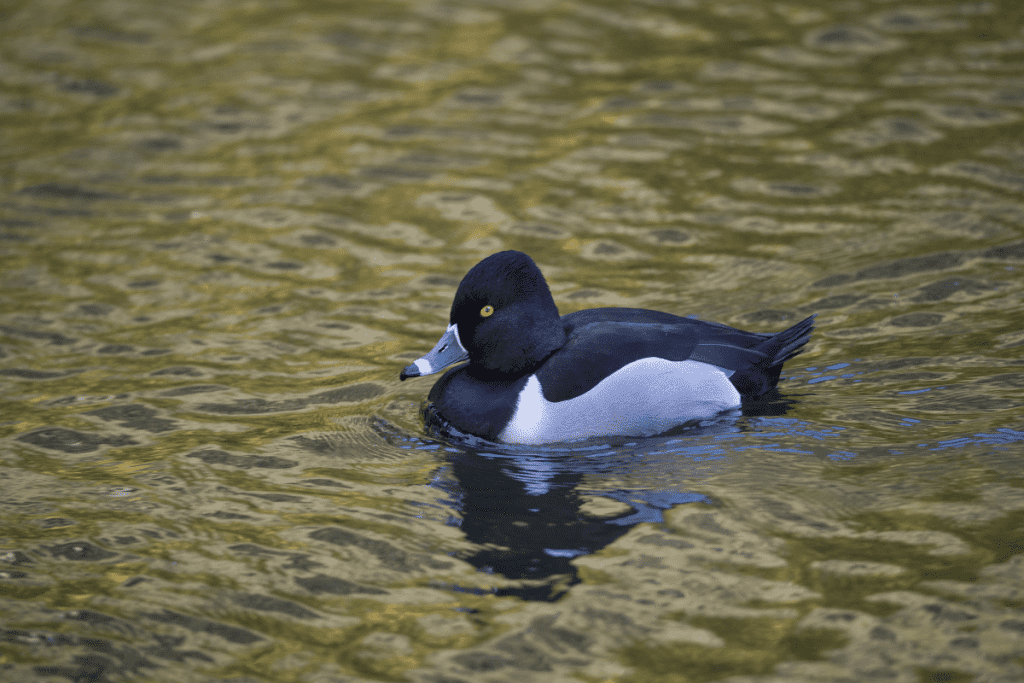
The ring-necked duck is a striking breed you’re not likely to forget if you’ve been lucky enough to spot it in the wild.
Despite not having very colorful feathers, these unique waterbirds have bright yellow eyes, which beautifully contrast their black and white coloration.
Their bills are also unique in coloration and pattern; they are primarily grey, with a white band and a distinct black tip.
Like many breeds of ducks, ring-necks display a high degree of sexual dimorphism.
This simply means the males of the breed look a lot different from the females.
While female ring-necked ducks have mostly brown feathers, the males’ plumage is a lot more visually interesting: solid purplish-black around the head, chest, and neck, white around the belly, and grey to black their wings.
Ring-necked ducks live throughout North America’s freshwater lakes and ponds.
They are diving ducks, meaning they hunt and eat by diving below the water’s surface in search of small fishes and insects.
Interestingly, the breed’s name comes from the ducks’ barely-visible brownish-red “ring” of feathers around their necks.
Muscovy
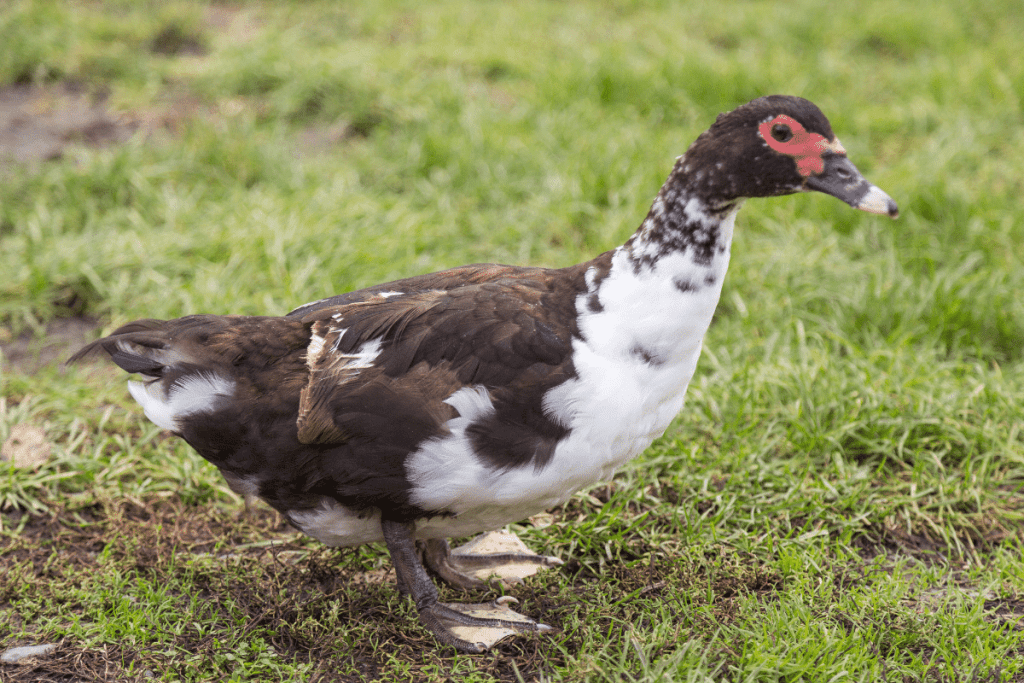
What’s black, white, and red all over?
A Muscovy duck!
This is one of the more common breeds on this list, as it has made its home not only in North America but also in Australia, South America, and even much of Europe!
If you’ve ever seen a Muscovy in the wild or as someone’s pet, you were likely a bit taken aback at first by the fleshy red stuff on its face.
Not to worry, as these are simply slightly modified caruncles or the same material which makes up chickens’ and turkeys’ wattles!
These unusual markings make the Muscovy duck unique and well-deserving of being highlighted on this list.
While Muscovy ducks exist in a wide variety of colors and patterns, the most common is a mixture of white and black patches all over the body.
As with most ducks, they display some sexual dimorphism; females’ feathers tend to be a lot duller than the males’, which are more bright and shiny to attract mates.
Oddly enough, the Muscovy’s name is a bit of a mystery.
The term “Muscovy” refers to the geographic area near Moscow in Russia.
However, the breed has likely never existed there naturally.
Most historians and animal biologists have suggested the ducks received this name sometime in the 15th or 16th century.
Nobody is exactly sure why, but many theories have arisen over the years.
Magpie Duck
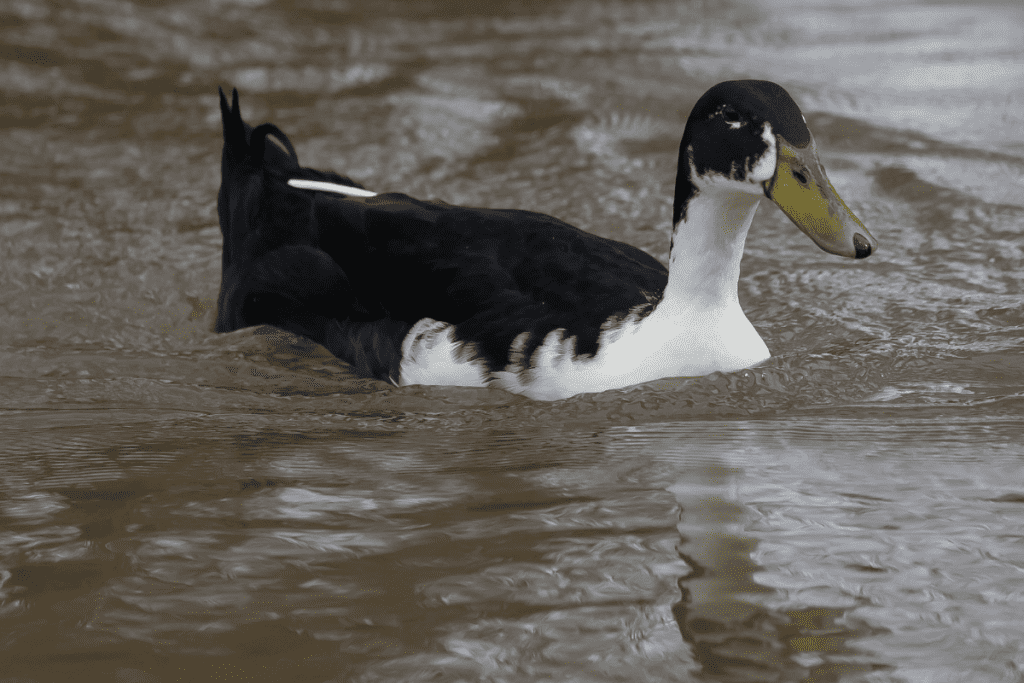
The Magpie duck was named for its distinct color and pattern, closely resembling the common magpie’s markings.
Native to the UK, it has become a popular breed amongst hobby farmers throughout the Americas and Europe starting around the 1960s and 1970s for its hardy, docile nature and attractive coloration.
It is also a common egg-laying breed.
If you’re looking to add another variety of duck to your backyard flock, this is an excellent candidate!
The breed was created sometime in the early 20th century after World War I, though most of its background details are unknown.
They are, however, believed to be related (at least distantly) to the Indian runner duck, as both breeds have a uniquely upright posture.
While their exact patterning often varies, Magpie ducks are primarily white with black splotches or patches around the head, back, and body.
Males and females aren’t as strikingly sexually dimorphic as most other breeds of ducks, but it is still fairly easy to tell them apart by the orientation of their tail feathers.
Male Magpie ducks have prominently curled tail feathers, while the females’ are straight.
Females also tend to be slightly smaller-bodied than males.
Ancona
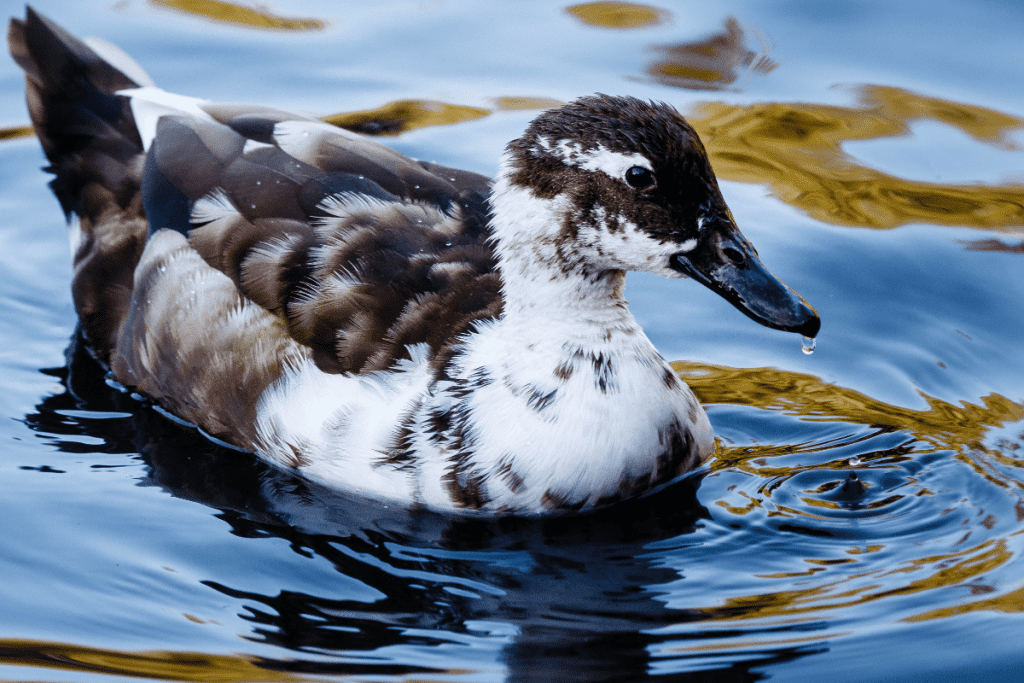
The Ancona duck is a bit similar in its feather coloration to the Magpie duck listed above, though the former’s pattern is usually far more irregular and varied.
While magpie ducks have a fairly uniform plumage style, Ancona ducks often have a mixture of black and white feathers all over their head, neck, and body.
This plumage varies significantly from individual to individual; some ducks will have larger patches of black versus white and on different areas of the body from one another.
This isn’t a mere coincidence, either; the Ancona breed most likely came from the same group of birds as the Magpie duck!
Both breeds originated sometime in the early 1900s in the UK.
The typical Ancona duck’s plumage is black and white, though other variations with colors like blue, brown, silver, and even lavender also exist.
They’ve become very popular as pets and livestock, as they are highly adaptable, have a strong, hardy build, and can lay over 200 eggs per year in ideal conditions.
Interestingly, their eggs have a wide range of potential shell colors, from the typical white to more vivid pastel blue and green shades.
Related: Do ducks lay eggs every single day?
Barrows’ Goldeneye
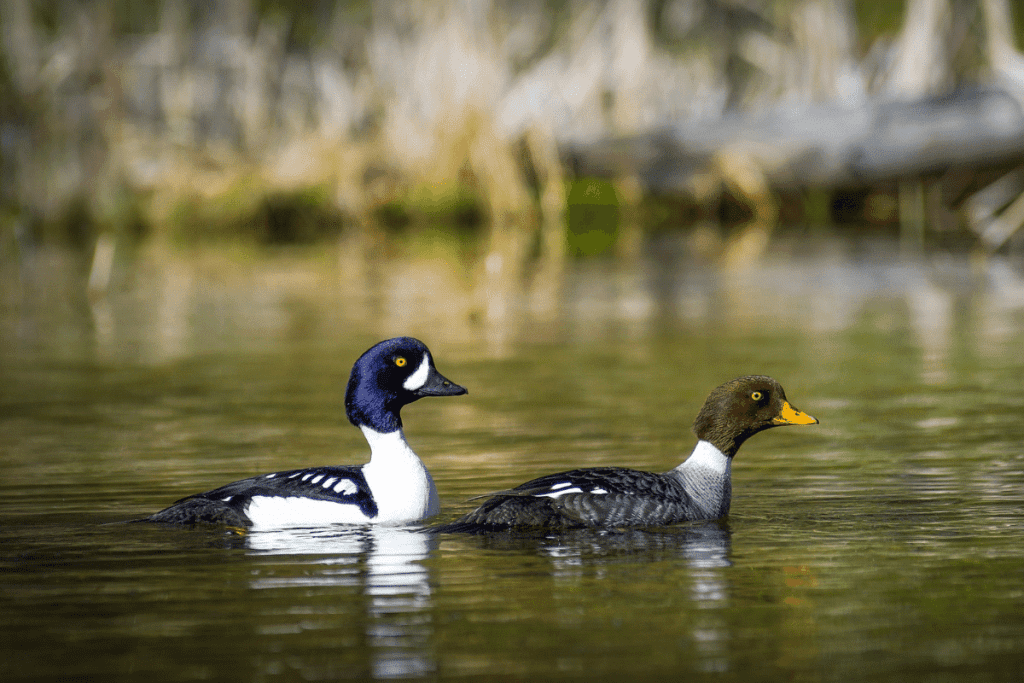
The Barrow’s goldeneye duck has a quite small native geographic range, making it one of the rarer varieties on this list.
They primarily inhabit North America’s northwestern coast, ranging from Oregon and Washington to Canada and even Alaska.
They’ve also been spotted in smaller populations in parts of Iceland!
This breed was named after Sir John Barrow, a famed English geographer, and linguist who was also a prolific writer.
The “goldeneye” part of the duck’s name comes from its vivid yellow eyes with striking, jet-black pupils.
Aside from this, the breed is mostly monochrome, with bluish-black or dark brown feathers around the head, neck, and back with white plumage on the chest and belly.
The females’ darker feathers tend to be more drab and brown, while those on the males are mostly black and have a sleek, iridescent sheen.
Males also typically have a small, white, elongated teardrop-shaped marking above their solid black beak.
These diving ducks aren’t kept as pets and haven’t been bred in captivity.
In the wild, the birds mostly feed on aquatic insects and other arthropods, though they are omnivores and eat various types of aquatic plants.
Common Merganser

Also known as the goosander in parts of Europe, the common merganser is a unique-looking sea duck with a wide geographic range stretching from North America to parts of Europe and Asia.
There are three separate subspecies of the breed, which vary only slightly in bill shape and plumage color/pattern.
Like many other duck breeds, the common merganser displays a high degree of sexual dimorphism.
While males are mostly white and black with an iridescent, greenish-black head (for most of the year, anyway), the females are much duller in color, mostly grey, white, and brown with light brown heads.
Additionally, when males are in “eclipse” for around three to four months a year or not actively breeding or seeking a mate, their plumage tends to shift to a grey and brown tone more similar to those of the females.
Both male and female mergansers have the same general body shape and size and a distinctly long, narrow, slightly curved bill shape.
This bill shape is commonly known as a “sawbill,” which has serrated edges like a knife to capture aquatic prey.
These seaducks feed entirely on various types of small fishes by diving underneath the water at high speeds, using their bills almost as spears which they “stab” into their prey.
Though they primarily feed on fish, mergansers will also eat various aquatic insects, crustaceans, mollusks, and even small amphibians on occasion.
They often alternate between fresh and saltwater as they are strong swimmers and live in areas where freshwater streams and rivers meet the sea.
If you want some smaller ducks, check out our picks for the best small duck species and breeds.
Tufted Pochard
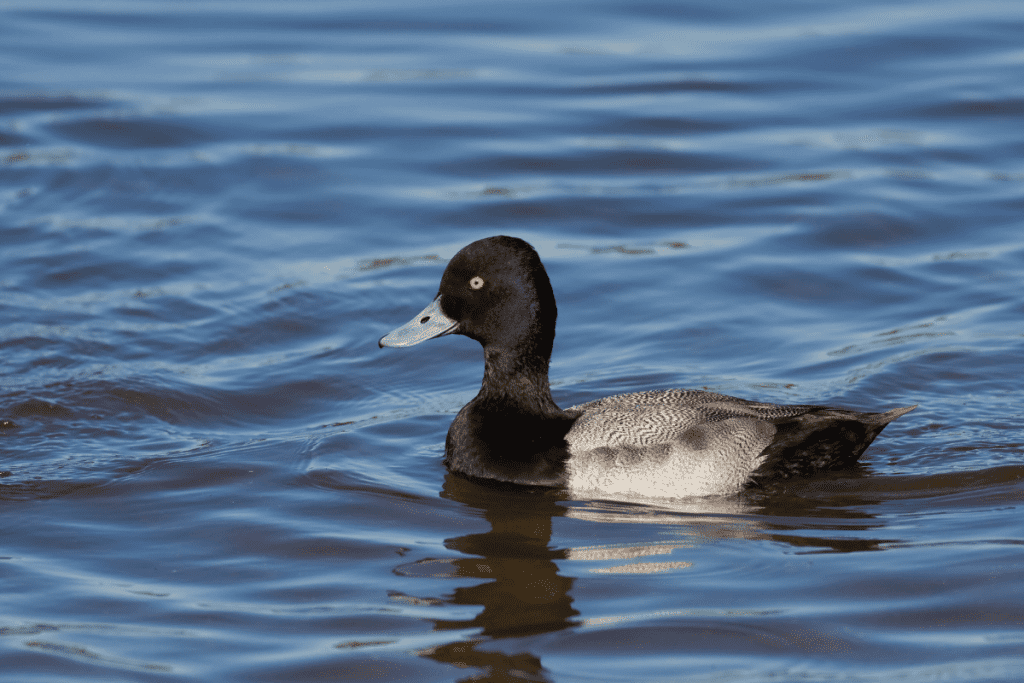
The tufted duck, also known as the tufted pochard, is named for the small tuft of slicked-back black feathers atop the males’ heads, but this is far from the breed’s only visually striking trait.
Both males and females have bright golden-yellow eyes and light grey bills with dark black tips.
They do, however, display some degree of sexual dimorphism.
While both sexes are mostly dark brown or black, the males have larger patches of white on their bellies, and their black feathers are much darker and have a slightly iridescent purplish shine.
Like many of the other breeds on this list, the females’ feathers are more brown and drab in coloration.
These handsome ducks primarily inhabit parts of eastern Europe and Eurasia, though they also often migrate to North America’s coasts in the winter.
They feed mostly on small fishes, mollusks, and aquatic insects, as they are skilled at diving for their prey.
However, they are omnivorous and also occasionally eat aquatic plants.
Surf Scoter

The surf scoter is a large sea duck with a uniquely-shaped, enlarged bill.
Males and females are highly sexually dimorphic.
The males’ bills are distinctly colored, with a mixture of red, yellow, and orange patterning and a vaguely circular black spot behind the nostrils and under the eyes.
Additionally, while the males are primarily black with a few small white splotches around the head and neck, females are mostly brownish-grey with darker brown atop the head.
These strange-looking diving ducks mostly inhabit North America, breeding in northern Canada during the warmer months and migrating to the United States’ coastal regions in the winter.
There are several different types of scoter ducks, though the surf scoter is the smallest, with females usually weighing around 2 lbs. and males weighing slightly more at around 2.5 lbs.
Surf scoters have a mostly carnivorous diet.
They mostly feed on small crustaceans, aquatic insects, and mollusks and often hunt in breeding pairs or small groups.
Bufflehead

Buffleheads are small sea ducks related to the aforementioned Barrow’s goldeneye (and most other goldeneye breeds in general).
These North American birds usually reside throughout much of the northeastern United States and Canada, though they often migrate much further south for the winter months.
The bufflehead’s name is a combination of “buffalo” and “head,” referring to the breed’s bulky, distinct head shape.
Like most species of ducks, the males look quite different from the females in color and patterning.
Females are mostly grey or brown with small white patches under the eyes and wings, while males have much more white on their chests and heads and are mostly black on their backs and tailfeathers.
Notably, the males also have bright, iridescent green and purple feathers around their eyes and bill.
The bufflehead is a small-bodied duck, measuring only around 13 to 15” inches long and weighing slightly less than a pound on average.
They inhabit both fresh and saltwater habitats and feed on various aquatic insects, crustaceans, and mollusks.
Smew
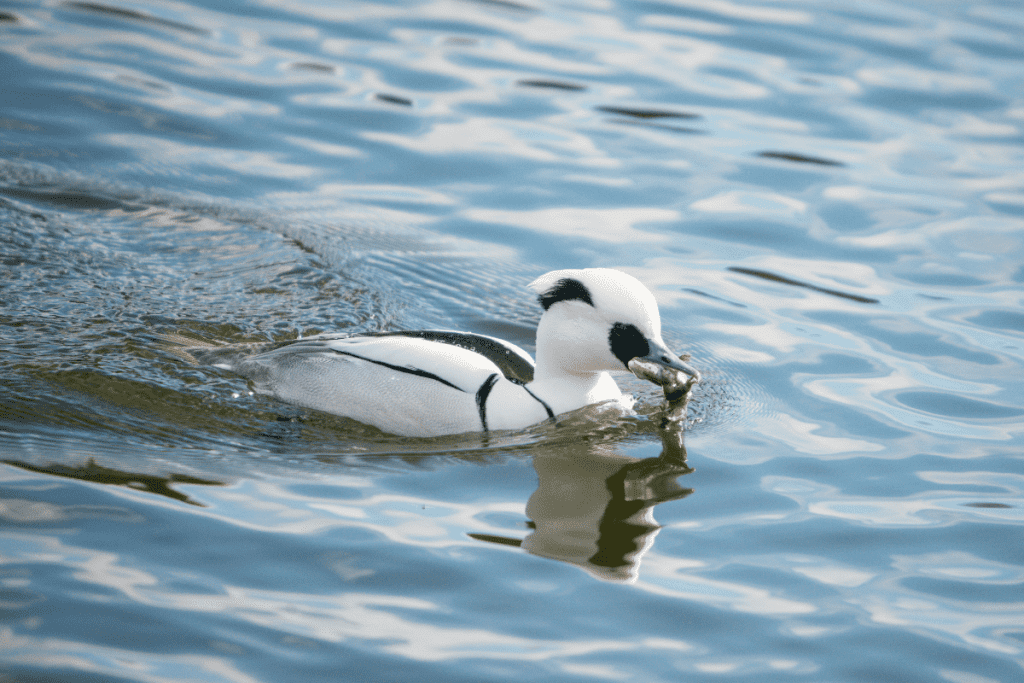
The smew is a bit of a bizarre breed, as it is the only remaining member of its genus, Mergellus.
This genus, however, is related to the Mergus genus of merganser ducks, and smews are also believed to be related to goldeneyes like the aforementioned Barrow’s goldeneye.
Historians are unsure where the term “smew” comes from, but some believe it comes from the slang term “smee,” which refers to wild ducks.
Though the females have more drab brown, white, and grey coloring, the males have distinct black and white coloration and patterning.
This patterning is sometimes called “cracked ice,” as the males are primarily white with thin black lines or patches throughout.
They also have a circular black marking or ring around the eyes, while the females’ heads are almost entirely brown.
These visually striking ducks mostly inhabit colder regions of Europe and Russia, though they migrate further south during the colder months.
They are notably very reclusive and primarily feed on small fishes.
How useful was this post?
Click on a star to rate it!
We are sorry that this post was not useful for you!
Let us improve this post!
Tell us how we can improve this post?
